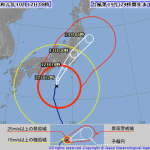There are many pentagons and hexagons in a soccer ball. Now, let’s calculate them.
Euler’s formula
On polyhedron, the following equation is valid.
(vertex count) – (edge count) + (face count) = 2
The proof of Euler’s formula is written on Think about Euler’s Formula on Polyhedron.
Now, using this formula, calculate the number of pentagons and hexagons. ( I calculated faces, etc. without Euler’s Equation on Soccer Ball and Regular Polyhedron . )
Calculate
Define \( m \) as the number of pentagons, and \( n \) as one of hexagons.
On soccer ball, one vertex is common in 3 planes. So, the number of vertexes on a soccer ball is expressed as \(\frac{5m + 6n}{3}\), the number of edges is \(\frac{5m + 6n}{2}\), the number of faces is \(m + n\) .
According to Euler’s formula, the following equation is valid.
$$ \frac{5m + 6n}{3} – \frac{5m + 6n}{2} + m + n = 2 $$
Now, calculate the above equation and get the value of \( m \) .
$$ m = 12 . $$
On a soccer ball, one pentagon neighbors 5 hexagons, and one hexagons neighbors 3 pentagons. Then, ( n ) is calculated as the following.
$$ n = \frac{5 m}{3} = \frac{5 \times 12}{3} = 20 . $$
From the above, the number of hexagons is 10, and the number of pentagons is 20.
You can calculate them with Descartes theorem. I wrote it on Proof of Descartes Theorem.
Note
The shape of Fullerene, C60, is the same as soccer ball. Let’s check whether the number of vertexes is 60.
$$ \frac{5m + 6n}{3} = \frac{5 \times 12 + 6 \times 20}{3} = 60 . $$
Reference
Euler’s formula is explained in the following book.









